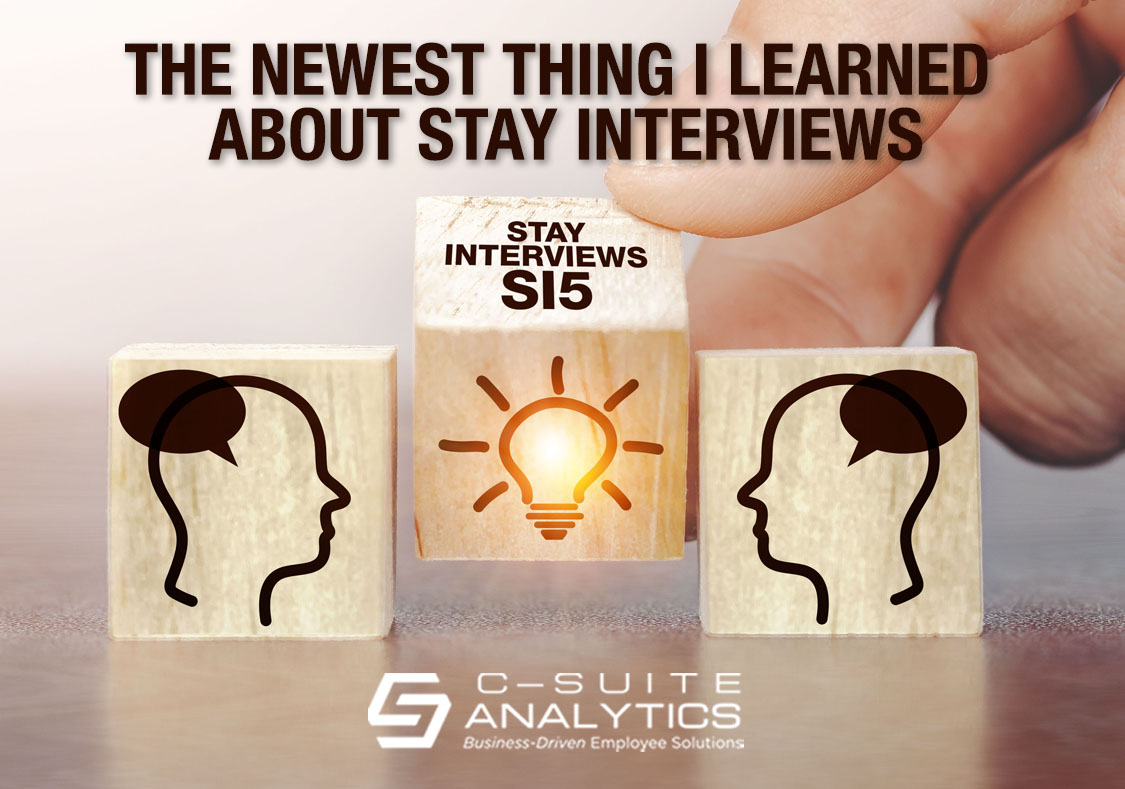Employee engagement hasn’t improved in 20 years—and Gallup says managers are the reason. Learn why corporate programs fail and what actually moves the needle.
The Newest Thing I Learned About Stay Interviews

We have a client with very high entry-level turnover where we are implementing customized solutions to fix it. And we WILL fix it. But this story is about the top of the organization rather than the bottom.
Our first in-person client session is named the Rethinking Retention Executive Summit®. In advance of this meeting we conduct two analytics…(1) place a dollar cost on turnover with inputs from Finance and HR, and (2) analyze all turnover data in order to recommend reasonable but aggressive turnover goals. This executive session, then, is about building out the business-driven architecture of retention…costs, goals, and accountability…as well as to agree to the parameters of the total retention solution we will deliver.
During this session we also train executives how to conduct Stay Interviews, wanting them to jump-start the Stay Interview process by role-modeling the correct way to do Stay Interviews from the top. We specifically ask them to launch Stay Interviews immediately after this session by scheduling them with their direct reports. Our thinking was these executives must experience the practical and emotional benefits of Stay Interviews so they support our implementing Stay Interviews several rungs below them on the organization chart. And we need their support with gusto.
But back to our high entry-level turnover client, where we got an outcome I didn’t expect. During a recent check-in call with the executive team, I asked if they had started doing their Stay Interviews. One senior executive responded quickly, speaking immediately after my question, and our exchange went like this:
- Me: “Have any of you begun your Stay Interviews yet?”
- Executive: “Absolutely. I already had mine with the plant manager.”
- Me: “That’s great news. How did it go?”
- Executive: “Really good. Better than I could have imagined.”
- Me: “Do you think your manager learned things about you that he didn’t know before?”
- Executive: “Oh yea, I’m sure that he did.”
- Me: “Do you think YOU learned things about you that you didn’t know before?”
- Executive after a pause: “Yea, I really did learn things about me that I didn’t know before.”
I’ve since verified this exchange with the executive to make sure I’m recalling these details correctly.
I see this discussion through two very different lenses, and both bring great power. The first is we just gained strength because these two executives plus everyone on our call heard this story so their belief in the effectiveness of Stay Interviews has rocketed up. The second perspective is imagining how impactful Stay Interviews can be when the employee who is responding to five specific questions says that HE learned something new about himself, just by answering those five questions.
I’m a therapist by training, and in that world these are called moments of discovery. These are those few-in-life times when we re-arrange our thinking because we’ve reached new levels of clarity, new degrees of understanding our subconscious better. We have shined new light/pulled the sheet off the statue for unlocking our inside view of ourselves.
But there is an even more important outcome from this exchange. The #1 goal of Stay Interviews is to build trust because, correspondingly, trusting one’s immediate supervisor is the #1 reason employees stay or leave, or engage or disengage, proven over and over. Imagine now talking with a close friend who asks you such a targeted, compelling question that you must dig so deeply inside you that by finding your response and articulating it that you’ve actually discovered something new about yourself…something previously unknown that suddenly opens doors to even fresher discoveries about you.
These exchanges are the basis of tight, reliable friendships. And the bedrock of our closest friendships in life is mutual trust.
Back in 2012 I didn’t see this coming. That’s when I authored The Power of Stay Interviews, which remains to this day the top-selling SHRM-published book in history. My goal was to build a process where managers could learn more about their employees to build trusting relationships in order to improve engagement and retention. Learning now that employees are learning more about themselves, too, is a bonus that will have an exponential impact on not just retention and engagement but on productivity as well.
We Cut Turnover 30% and More! Please email your comments to me at DFinnegan@C-SuiteAnalytics.com. You are also welcome to forward this blog to anyone you believe would find it helpful.



